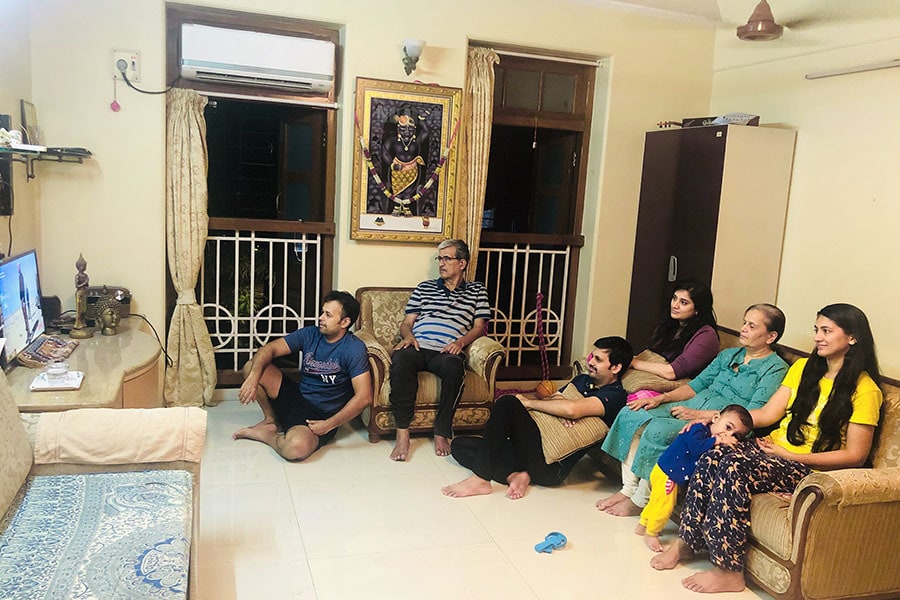
OTTs: The new family TV
With a surge in viewership during the lockdown, most digital platforms feel big movies will also opt for online-first releases in a post-Covid-19 world
 Rohan Paleja (extreme left) and family binge-watch shows on OTT platforms during the Covid-19 lockdown
Rohan Paleja (extreme left) and family binge-watch shows on OTT platforms during the Covid-19 lockdown
Almost every Saturday evening, Rohan Paleja is at a theatre in South Mumbai, watching the latest film with his wife Vishakha and friends. However, since March 24, when the lockdown came into effect in the wake of the coronavirus pandemic, the businessman dealing with textile interlinings finds it hard to distinguish between weekdays and weekends. Instead of his daily commute to his factory in Bhiwandi on the outskirts of Mumbai, the resident of Gowalia Tank near Grant Road now spends his mornings looking after his sons Yug (3) and Vir (1). What has not changed, though, is his love for devouring content.
With theatres shut, Paleja now binge-watches shows and movies on over-the-top (OTT) platforms on most evenings, often with his entire family. “I prefer watching OTTs over television [TV] because I can choose what I want to see. Besides, these platforms provide varied and quality content with fantastic visuals and rich storytelling,” says Paleja, who is in his 30s and has seen Money Heist, Fauda, Special Ops, Panchayat and Hostages, among other series during the lockdown. “It’s taken me back to my childhood days when we, as a family, would regularly watch TV together.” He admits that he would catch up on OTT shows even during his travel to work, but the frequency has increased these days as there is more time at his disposal.
Vishakha is only glad with the time spent together. “It’s strengthened our family bond. On regular days, it’s almost impossible for all of us to step out together because of everyone’s busy and erratic schedule. This has brought us closer as we soak in the atmosphere at home and enjoy multiple shows,” she says. In the absence of other avenues of entertainment, OTTs have benefited during the lockdown, adding subscribers and gaining more viewers on various shows. “Our overall subscription grew by 2x in the last couple of months and we also saw huge engagement from our existing consumers during the Covid-19 pandemic. Also, we witnessed content consumption throughout the day as people were at home all day,” says Rahul Maroli, senior vice president and head-subscription video on demand at Zee5.
Nachiket Pantvaidya, CEO, ALTBalaji, and group COO of Balaji Telefilms, concurs, saying the platform even acquired audience from non-metros during this period. “We grew from a base of 10,000 subscribers every day to 15,000 to 20,000 subscribers daily in the past 40 days. We are seeing newer audiences coming in, especially from tier II and III towns,” he claims.
A recent report by Broadcast Audience Research Council-Nielsen suggests TV viewership recorded 1.10 trillion viewing minutes and grew by 24 percent in the week starting May 2 compared to pre-Covid-19 levels. Smartphone-based consumption continues to be at about 4 hours per day, 14 percent higher than before the lockdown. The unprecedented national lockdown meant shootings for films and TV serials came to an abrupt halt and fresh content could not be created. With streaming platforms seeing increased viewership across age groups, and on connected devices, they had to alter their strategies during this period.



 Two versions of Mentalhood are available on Zee5, one made for family viewing
Two versions of Mentalhood are available on Zee5, one made for family viewing
 Ghoomketu starring Nawazuddin Siddiqui had a digital release in May
Ghoomketu starring Nawazuddin Siddiqui had a digital release in May
 National broadcaster Doordarshan revived classic shows from the 1980s and 90s during the lockdown
National broadcaster Doordarshan revived classic shows from the 1980s and 90s during the lockdown





